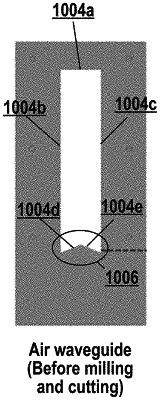| CPC H01Q 21/005 (2013.01) [H01Q 1/38 (2013.01); H01Q 13/26 (2013.01); H01Q 21/0043 (2013.01); H01P 5/107 (2013.01)] | 14 Claims |

|
1. A method of fabricating an antenna array, the method comprising:
providing a ground plane having a reflective planar surface formed of a conductive material;
attaching an air-waveguide structure to the ground plane, the air-waveguide structure defined by a waveguide width W and waveguide length L, the air-waveguide structure having a slotted aperture defined, in part, by two conductive side walls that terminate at a conductive end wall, wherein a portion of the two conductive side walls and a portion of the conductive end wall collectively define an aperture-facing radiative conductive surface of the slotted aperture, wherein the slotted aperture has been fabricated by:
i) having a polygonal aperture formed in a stock material, the polygonal aperture comprising five or more edges, wherein three of the five or more edges define the two conductive side walls and the conductive end wall, and wherein a remaining two or more of the five or more edges define an intermediate-shaped region opposite the conductive end wall,
ii) plating the five or more edges of the polygonal aperture with a conductive layer,
iii) removing the intermediate-shaped region to form a non-conductive end wall that is opposite the conductive end wall, and
wherein the aperture-facing radiative conductive surface of the slotted aperture electrically couples with a conductive antenna feedline of the antenna array; and
attaching a slotted cover plate onto an exterior surface of the air-waveguide structure, wherein the slotted cover plate has an area that fully covers the slotted aperture, wherein the slotted cover plate has two or more radiating slotted apertures coincident to the slotted aperture of the air-waveguide structure.
|